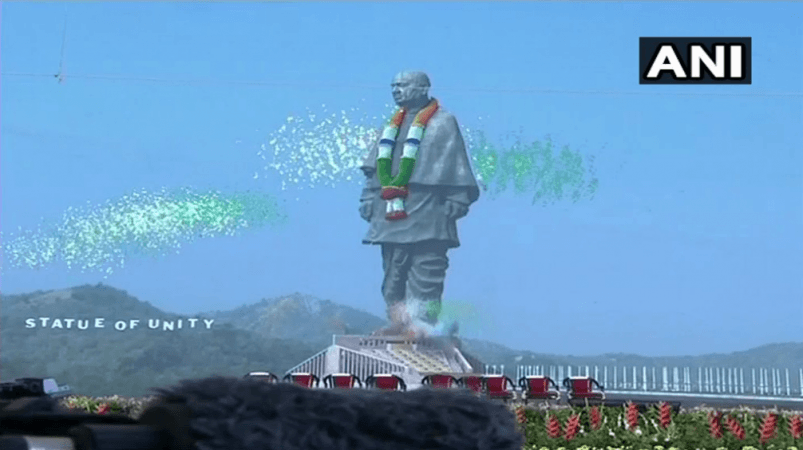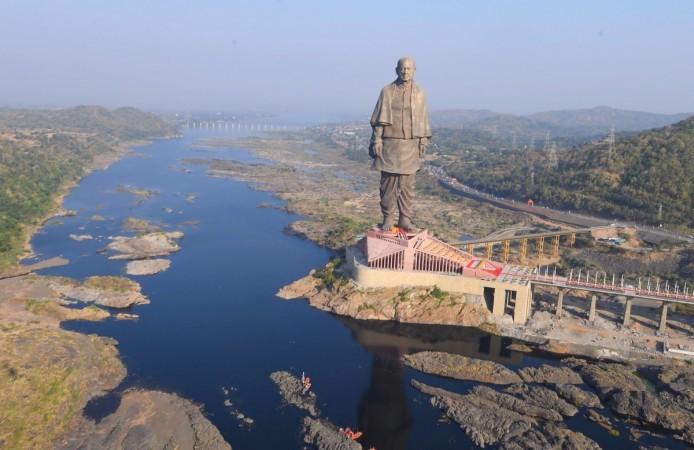The world's tallest statue by a long mile has just been opened in Gujarat, India. Standing at a height of 240 metres, including the base, it is over twice as tall as the Statue of liberty.
Built overlooking the Sardar Sarovar Dam, the statue is about 200 km from the nearest city, Ahmedabad. While the imposing structure of the statue is nothing short of an engineering masterpiece calling all Indians under a united flag by one of its most eminent leaders, there is a dark side to this construction project that is seemingly in the middle of nowhere, surrounded by mountains, forests, farms and rivers.

The astronomical cost of this project is seen by many, including the locals, as a massive waste of money—about Rs 2,900 crores or $430 million. Money that could have gone into other projects to develop the region, irrigation of farmland, for example.
According to a report by the BBC, farmers in the region, without having any way to water their crops have simply chosen to work at the construction site for the last few years.
While the Gujarat government, which is reported to have borne about half the cost of construction maintains that the statue will bring in a booming tourism-based industry to the region, averaging 2.5 million visitors a year, locals are seemingly not so convinced.
"We want to ask the government: why can't they fund a project to support farmers and improve their standard of life?" said Lakhan, a tribal activist in the region.
"We were promised water for irrigation but the situation remains the same."

Nana Pipaliya, a village close to the project falls under the "command area" of the Sardar Sarovar Dam and these are lands that were supposed to get water from irrigation projects, notes the report. Farmers, in the region, however, are yet to receive any. This is a region where 85 percent of the population is involved in agriculture, according to the 2011 census.
Farmers are not the only group of people that are seemingly unhappy with the Statue of Unity. A report by BI notes that 22 villages surrounding the Statue have through their Headman written an open letter to PM Narendra Modi that he would not be welcomed to the location. "These forests, rivers, waterfalls, land and agriculture supported us for generations. We survived on them. But, everything is being destroyed now and celebrations are also planned. Don't you think its akin to celebrating someone's death? We feel so," read the letter, signed by Sarpanchas of 22 villages, notes the report.
"... you [Modi] are not welcome here," it read.
Tribal leaders had also planned a protest on the day of the Statue's inauguration, but they were detained and held by the police ahead of it, reports IndiaToday. Gujarat police reportedly went up to several local leader's homes and arrested them pre-emptively under IPC Section 68. This included tribal leaders in the Kevadia, Rajpipla and Dediapada talukas (blocks).
"Our jal (water) zameen (land), and jangal (forest) belong to us," said Govind Tadvi, the sarpanch of Vaghadia village. This village, notes the HT, has actually lost all of its farmland to various government projects, he said.
"None of us will cook or eat tomorrow [the day of the inauguration]."
Made in China?
While most of the statue was made using Indian material, including many tons of iron collected by the government from farmers themselves, Congress leader Rahul Gandhi, in September made waves for calling the Statue of Unity "Made in China". "Look how he [Modi] insulted Sardar Patel. His statue was built, and behind it, it was written Made in China," he said.
While there was a Chinese contribution in the construction of the Statue, the company tasked with its construction, Larsen and Toubro made a statement back in 2015, reports the Financial Express, that only the bronze cladding in the form of plates was sourced from China, amounting to about nine percent of the total value of the project.










